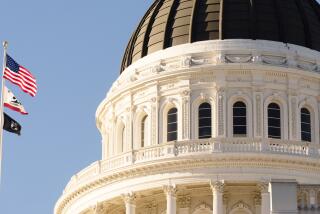Where does it all go?
California state government spent $145 billion last fiscal year, $41 billion more than four years ago when Gov. Gray Davis got recalled by voters. With all that new spending -- a whopping 40% increase -- we ought to be in a golden age of government with abundant public services for all.
So why does it seem like the quality and quantity of government is not all that different from 2004? How many of us feel like we are getting 40% more public services, 40% better schools, roads, parks and so on?
The Legislature and governor, grappling with another huge budget deficit, are suggesting raising taxes, so it seems opportune to ask what we got from the last $41 billion.
Some of it went to cover increases in the cost of living, and state spending naturally grows with the size of the population. But even adjusting for inflation and population growth, state spending is up almost 20% compared with four years ago, a big enough bump that ordinary Californians should be able to notice it. The state’s financial statements describe where the money went -- the big gainers were education ($13 billion), transportation ($10 billion) and health ($10 billion) -- but not why these billions don’t create even a blip on our day-to-day radar.
One possibility is that we simply do not notice all of the valuable services we receive. A national 2007 survey by William G. Howell at the University of Chicago and Martin R. West at Brown University found that respondents underestimated spending in their school district by 60%; on average, they believed spending was $4,231 per student when in fact it was $10,377. They also found that Americans underestimated teacher salaries by 30%. How many Californians know that public school teachers in the state earn an average of $59,000 a year, essentially tied with Connecticut for the highest average pay in the country? Likewise, perhaps we don’t notice the repaired roads or new buses and trains that take us to work.
On the other hand, maybe these billions of dollars just do not translate into services that are valuable to us.
Is paying the highest teacher salaries in the country delivering a better education for our children? Are roads and transit being built near where we live? Do big raises for prison guards promote rehabilitation and lead to more humane prisons? If funds are being directed to satisfy powerful special interests -- teachers, builders, prison guards -- rather than everyday people, the spending might not result in tangibly improved services for the typical Californian.
The reason this matters right now is that the state is at a budget juncture. Almost by accident, without any significant changes to the tax code, state revenue grew more than 30% over the last four years, so the Legislature and governor were able to fuel the state’s spending growth without burdening the taxpayers.
But those days of revenue windfalls appear to be over. To bring the budget into balance, the state now has to reduce the rate of spending growth or raise taxes.
The governor has floated the idea of higher sales taxes, and the Legislature wants to increase the income tax on high-earners -- but the state already seems to be pushing the boundary on taxes.
California’s statewide sales tax of 7.25% is already the highest in the nation. Income taxes are also high, with the 10.3% rate on the top income bracket the highest in the nation. The highly progressive nature of the state’s income tax schedule -- the top 10% of earners supply more than 70% of income tax revenue, according to one estimate -- already results in excessive revenue volatility. It also raises questions about how much redistribution of wealth is fair: Should the top 10% foot the bill for basic services enjoyed by all Californians?
Legislators, pundits and interest groups warn of dire consequences if state spending is slowed or cut. But if most Californians haven’t detected a significant change from the last $41 billion, including 40% more on schools, will they notice if some of that spending disappears?
Voters are criticized for wanting more services yet being unwilling to pay higher taxes. That is unfair; Californians have repeatedly demonstrated their willingness to fund valuable programs. But if spending can go up 40% and most of us can’t discern any difference, can we blame voters for being hesitant to put even more tax money in the hands of the state?
More to Read
Sign up for Essential California
The most important California stories and recommendations in your inbox every morning.
You may occasionally receive promotional content from the Los Angeles Times.










